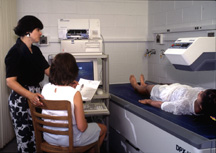 Purdue News
Purdue News
 Purdue News
Purdue News

|
The new data were instrumental in developing the revised Recommended Dietary Allowances, which were announced Wednesday (8/13). The recommendations are produced by the National Academy of Sciences and used by the Food and Drug Administration and others.
The new Recommended Dietary Allowance (which the National Academy of Sciences is renaming the Dietary Reference Intake, or DRI) calls for between 1,000 and 1,300 milligrams of calcium per day. For adolescents in age groups 9 to 13 and 14 to 18, the new recommendations call for 1,300 milligrams of calcium per day.
Distinguishing between adolescents and adults in the guidelines is important, Weaver says, because bone growth occurs almost exclusively during adolescence, or during the years following the onset of puberty for women. "Your window of opportunity for bone growth occurs while you're pretty young," she says.
Weaver and other researchers from Purdue and the Indiana University School of Medicine determined that an intake of 1,300 milligrams of calcium per day offered maximum bone growth for females ages 12 to 15. "That's important, because the more bone you build up early in life, the more you can use up later in life," Weaver says.
Purdue nutritional educator Lisa Jackman, the primary investigator on this research study, says, "The new numbers for adolescents are based on our research, which is also just being released. This information is completely up-to-date."
The study appears in the August issue of the American Journal of Clinical Nutrition. It was used by the National Academy of Sciences' Food and Nutrition Board's Dietary Reference Intake Committee to help establish the new calcium requirements. Weaver is a member of the committee's panel that is looking at bone-related maturity and the related nutritional requirements.
"This paper provides the model for setting the nutritional guidelines," Weaver says.
In 1989 the Recommended Dietary Allowance for calcium for adolescents was set at 1,200 milligrams per day. "This level would achieve a mean of 57 percent of maximized peak bone mass," Weaver says. "Our paper calls for an increase in calcium intake." Weaver recommends 1,300 milligrams of calcium per day. A cup of milk or yogurt contains about 300 milligrams of calcium, so the new standard for adolescents calls for four and a half to five cups of dairy products every day.
Calcium, which makes up much of bone, is an essential element for many body functions. As the body ages, it gets some of the calcium it needs by slowly breaking down bone material. Excessive loss of bone material and minerals as a person ages is a disorder called osteoporosis. This condition can cause bones to become thin and weak, resulting in a greater chance of fractures and other injuries. In severe cases, osteoporosis also can cause a person's shoulders to round and the upper back to deform, resulting in the unfortunately familiar dowager's hump.
Osteoporosis affects 35 million Americans -- nearly four times as many women as men -- at an annual cost of $13 billion. As the average age of the U.S. population rises, the problem is expected to get worse.
Weaver's study found that adding more calcium to the diet works, up to a point. "The bone mass keeps increasing along with the increasing calcium intake until it reaches a certain point, and then it plateaus. Any calcium intake above that doesn't really do you any good," Weaver says.
To some extent, how much more calcium the recommendations call for is a moot point, because nine out of 10 teen-age girls don't meet the current RDA.
"We're pushing the recommendation up to five cups per day, and they're not yet getting the four cups per day that we've already been calling for," Weaver says. "A big part of the problem is that girls have substituted soda for milk with their meals."
The increased consumption of dairy products doesn't have to mean increased fat consumption, too, Weaver says. "Today, these products all offer no-fat versions, so that shouldn't stop anyone from eating enough diary products."
According to Weaver, the new dietary recommendations for calcium are the first of a new set of dietary standards. For the first time the recommendations will be for both the United States and Canada. Six new Dietary Reference Intake recommendations for folate and B vitamins, antioxidants, macronutrients, trace elements, electrolytes and water, and other food components will be released in the future by the National Academy of Science.
Sources: Connie Weaver, (765) 494-8231; e-mail, weavercm@cfs.purdue.edu
Lisa Jackman, (765) 494-6566; e-mail, jackmanl@cfs.purdue.edu
Writer: Steve Tally, (765) 494-9809; e-mail, tally@ecn.purdue.edu
Purdue News Service: (765) 494-2096; e-mail, purduenews@purdue.edu
Calcium retention in relation to calcium intake and postmenarcheal age in adolescent
females
PHOTO CAPTION:
Color photo, electronic transmission, and Web and ftp download available. Photo ID:
Weaver/Adolescents
Download Photo Here
NOTE TO JOURNALISTS: